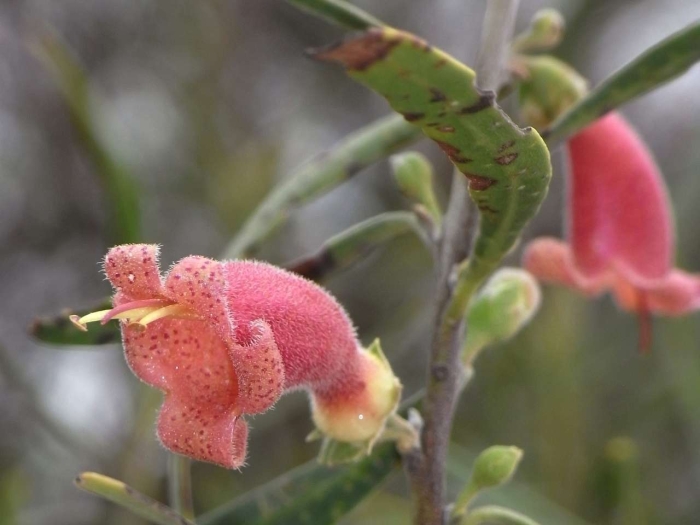Berrigan
(Eremophila longifolia)
Berrigan (Eremophila longifolia)
/
/

Russell Best
CC BY 4.0
Image By:
Russell Best
Recorded By:
Copyright:
CC BY 4.0
Copyright Notice:
Photo by: Russell Best | License Type: CC BY 4.0 | License URL: http://creativecommons.org/licenses/by/4.0/ | Rights Holder: Russell Best | Publisher: iNaturalist | Date Created: 2009-10-01T11:36:05Z |

























Estimated Native Range
Summary
Eremophila longifolia, commonly known as berrigan, is a versatile shrub or small tree endemic to a range of arid and semi-arid habitats across Australia, including mallee communities, Acacia or Eucalyptus woodlands, rocky hills, sand plains, and sand dunes. It is found across all Australian mainland states and the Northern Territory. Berrigan can vary significantly in size, from 3 to 30 feet tall, and is characterized by its weeping branches, long narrow leaves, and brick-red or pink tubular flowers that bloom sporadically throughout the year, with a peak in spring and summer. The flowers are particularly attractive to nectar-feeding birds such as honeyeaters. The plant may form dense stands through suckering, which can be advantageous for erosion control.
Eremophila longifolia is valued for its drought tolerance and ability to thrive in poor, dry soils, making it an excellent choice for water-wise gardens and reclamation projects. It is often used as a hedge or screen and can be pruned to maintain a desired shape. Berrigan requires full sun and well-drained soil, and once established, it has low water requirements. While it is generally disease-resistant, it can be susceptible to root rot in poorly drained soils. In addition to its horticultural uses, Eremophila longifolia holds cultural significance for Aboriginal people, who use it for ceremonial purposes, medicinal applications, and as a fodder plant for livestock during droughts.CC BY-SA 4.0
Eremophila longifolia is valued for its drought tolerance and ability to thrive in poor, dry soils, making it an excellent choice for water-wise gardens and reclamation projects. It is often used as a hedge or screen and can be pruned to maintain a desired shape. Berrigan requires full sun and well-drained soil, and once established, it has low water requirements. While it is generally disease-resistant, it can be susceptible to root rot in poorly drained soils. In addition to its horticultural uses, Eremophila longifolia holds cultural significance for Aboriginal people, who use it for ceremonial purposes, medicinal applications, and as a fodder plant for livestock during droughts.CC BY-SA 4.0
Plant Description
- Plant Type: Shrub, Tree
- Height: 4-10 feet
- Width: 4-8 feet
- Growth Rate: Moderate
- Flower Color: Pink
- Flowering Season: Summer, Spring
- Leaf Retention: Evergreen
Growth Requirements
- Sun: Full Sun
- Water: Very Low
- Drainage: Fast
Common Uses
Bee Garden, Bird Garden, Drought Tolerant, Low Maintenance
Natural Habitat
Mallee communities, Acacia or Eucalyptus woodlands, rocky hills, sand plains, and sand dunes
Other Names
Common Names: Longleaf Emubush, Berrigan
Scientific Names: , Eremophila longifolia, Bondtia graciliflora, Bondtia longifolia, Bontia graciliflora, Bontia longifolia, Eremophila graciliflora, Eremophila salicina, Pholidia longifolia, Stenochilus longifolius
GBIF Accepted Name: